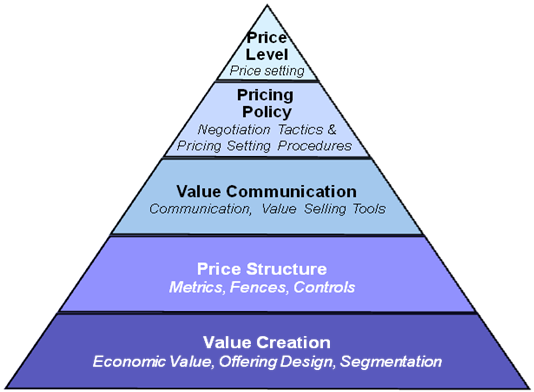
Pricing is the single greatest lever you have to improve profitability, and your profits will increase further when you price strategically. Strategic pricing is about proactively creating the conditions under which better and more-profitable pricing outcomes are the natural result. So, what exactly is Strategic Pricing?
Some define Strategic Pricing as value creation. Some define it as being competitively aware. Others will use it to describe establishing a company’s price levels and bands. There are therefore a number of definitions and slight differences in opinion but generally strategic pricing incorporates best practices in pricing and ensures that your pricing strategies, analytics and pricing processes complement your business strategy.
Strategic pricing sets a product's price based on the product's value to the customer, or on competitive strategy, rather than on the cost of production. This approach recognises that people often make purchasing decisions based more on psychology than on logic, and that what is most valuable to the customer may not be what's most expensive to produce. By creating strategic pricing policies, analytics, and processes, you can directly capture customer value and turn that value into shareholder value.
The Pricing Pyramid and 9 Strategic Pricing Steps
A comprehensive pricing strategy is comprised of many layers creating a foundation for price setting that minimises erosion and maximises profits over time. These layers combine to form a strategic pricing pyramid. Value creation forms the foundation of the pyramid. A deep understanding of how products and services create value for customers is the key input to the development of a price structure that determines how your offerings should be priced.
When considering your approach to strategic pricing and applying this to the pricing pyramid, these are key steps you should use:
- Market Analysis: Thoroughly analyze the market, including customer behavior, competitor pricing strategies, and industry trends.
- Value Proposition: Identify and emphasize the unique value that the product or service offers compared to competitors, and set prices accordingly.
- Cost Evaluation: Assess production, distribution, and marketing costs to establish pricing that covers expenses while ensuring profitability.
- Pricing Objectives: Clearly define pricing goals, such as maximizing profits, expanding market share, entering new markets, or fostering customer loyalty.
- Segmentation and Tiers: Tailor pricing to different customer segments or create pricing tiers based on features, usage, or customer preferences.
- Pricing Elasticity: Gauge customer sensitivity to price changes and adjust pricing strategies to optimize revenue.
- Promotions and Discounts: Strategically use temporary price reductions, promotions, or discounts to achieve specific marketing and sales objectives.
- Long-term Planning: Consider the long-lasting impacts of pricing decisions on brand perception and customer relationships.0
- Monitoring and Analysis: Continuously monitor market conditions, customer feedback, and pricing performance to adapt strategies as necessary.
Significance of Strategic Pricing
What customers are willing to pay for a product may be vastly more, or less, than a company would charge if it simply priced based on cost. Discovering what consumers value about your product can allow a company to increase its price – or, alternatively, might even suggest that a new product has no chance of being profitable.
Alternatives to Strategic Pricing
Traditional pricing is set either based on the cost of production or on the price that competitors are
charging. Sometimes this is a reasonable approach but when multiple competitors produce the same product at the same price, the only way to compete is to offer a discount. Pricing a company's product strategically is therefore key to avoiding price wars.
Example of Strategic Pricing
Software companies often use strategic pricing because they cannot price on cost. They usually don't know how many copies they will sell, and there is virtually no incremental cost for producing more units. Suppose they poll their potential customers and determine that some people want to use the software a little bit every day, and some want to use it intensely a few times a year? This may lead the company to offer two different pricing plans for the same software, e.g. a £19.99 monthly subscription and a £4.95 per use fee.
Tips for Strategic Pricing
- Strategic pricing is a marketing decision, which means it should be informed by dialogue with your customers.
- Keeping a close eye on your competitors is important, but remember they are not the ones purchasing your product, and they may be making mistakes in their own pricing.
- Recognise what your customers value and charge them accordingly rather than going head to head on price with competitors.
How to Measure Value
Is it possible to put a price on importance or satisfaction? Does the fact that your product scores 10% higher on satisfaction than your competitor's product always mean that customers will be willing to pay a 10% higher price? The answer is generally a "no" – but there are exceptions – see the Intel example below.
When the Intel Premium chip was first introduced and competitors rose to the competitive challenge, Intel's research showed that end-customers were more likely to purchase a computer when they knew that the processor was made by Intel – because they valued the Intel chip so highly. In addition, customers were willing to pay more for a computer with an Intel chip. Intel launched the "Intel Inside" campaign in order to command a price premium for its chips.
Measuring the value of your product requires an intimate knowledge of your customer's needs which can then be translated into a value estimate - and in business the value estimate generally centres on the economic impact a product or service has on the customer's costs and revenues.
Price and Value Communication
Poor communication of value results in higher price sensitivity and more intense price negotiations. Customers might not understand the value of your product or service because they may be unaware of new features, lack knowledge about how to use them, or not understand how a particular feature might satisfy an unmet need. Your marketing department needs to address these issues through effective price and value communications.
Conclusion
One reason companies find pricing challenging is because they lack a systematic process to translate such diverse inputs as customer value, costs, broad strategic objectives and competitor prices into the right price.
Building a strategic pricing capability requires more than a common understanding of the elements of an effective strategy. It requires careful development of organisation structure, systems, individual skills, and ultimately culture. These things represent the foundation upon which the strategic pricing pyramid rests and must be developed in tandem with the pricing strategy.
The first step towards strategic pricing is to understand each level of the pyramid and how it supports those above it.
Sources
http://www.pricingbrew.com/insights/so-what-is-strategic-pricing-really/?
http://smallbusiness.chron.com/strategic-pricing-11751.html
http://pricing2b.com/web_documents/what_is_strategic_pricing.pdf
The Strategy and Tactics of Pricing, Tom Nagle and John Hogan 2016
What is Strategic Pricing? John Hogan and Thomas Nagle, 2005
Pricing with Confidence: 10 ways to stop leaving money on the table by Reed K Holden and Mark Burton, 2014
Pricing Strategy: tactics and strategies for pricing with confidence by Warren D. Hamilton, 2014
Pricing Strategy: how to price a product by Bill McFarlane, 2012
Pricing for Profit: how to develop a powerful pricing strategy for your business by Peter Hill, 2013





